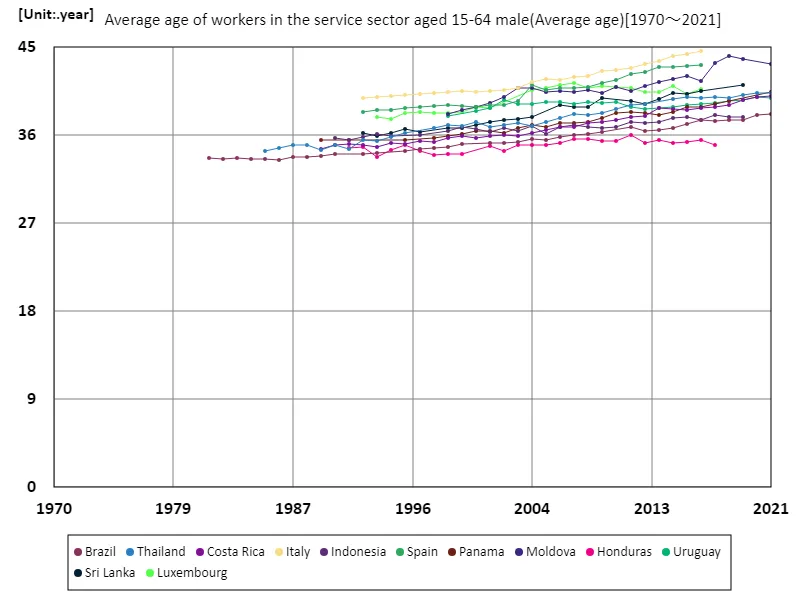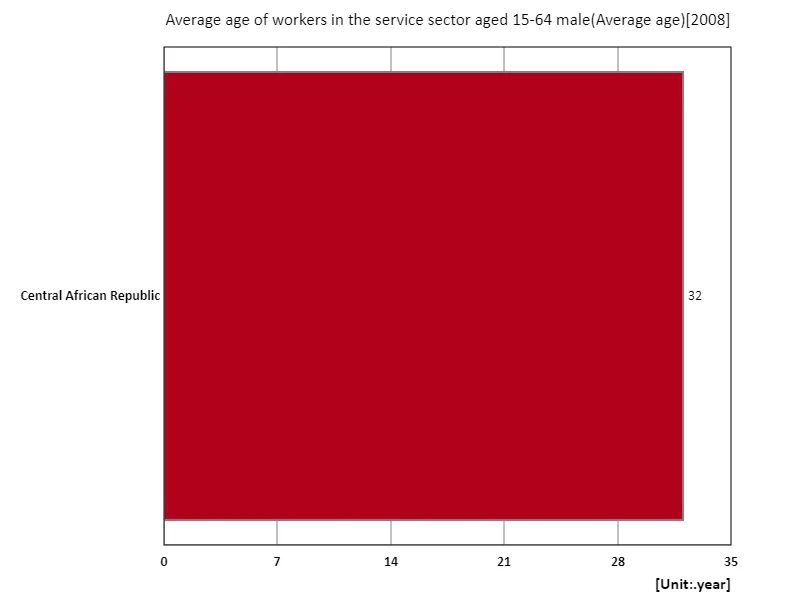Abstract
The fact that the average age of male workers aged 15-64 in Moldova’s service sector is 43.3 years suggests several important economic and social factors. Generally, when the average age of workers in the service sector is higher, it is often the case that the labor market is mature and there are many older people working there. This means that labour force participation is high and spread across a wider age range. In particular, in economically developing countries like Moldova, there tends to be a shortage of young workers due to limited economic stability and employment opportunities. Historical data shows that as economies mature, the average age of workers in the service sector tends to increase. Moldova’s high average age is therefore an important indicator of changes in the economic structure and the maturity of the labour market.
Service sector, male workers aged 15-64, average age
The fact that the average age of male workers aged 15-64 in Italy’s services sector was recorded at 44.6 in 2016 reflects several economic and social factors. First, across the 1981-2021 data, the average age of service sector workers has generally been increasing. This indicates that the population as a whole is ageing, with developed countries especially seeing an increase in the age group. In Italy’s case, the average age peaked at 44.6 years and has remained at that level ever since, reflecting the stability of the labor market and the high labor force participation rate of older people. In Italy, factors such as the social security system, a rising retirement age, and the rising cost of living are encouraging older people to join the workforce. Additionally, service sector jobs tend to have an older workforce because they require more experienced workers. This ageing reflects the maturity of Italy’s labour market and the need for older workers, and is influenced by structural and demographic changes in the economy. Overall, we can say that developed countries are continuing to see an increase in the average age of service sector workers.


The maximum is the latest one, 44.6year of Italy
Service sector, male workers aged 15-64, average age (worldwide)
Considering data from 1981 to 2021, it is clear that the average age of male workers aged 15-64 in the service sector has been increasing. The average life expectancy of 44.6 years recorded in Italy in 2016 is a particularly striking example of this trend. Italy’s high average age reflects the effects of mature and ageing labour markets in developed countries. The service industry, by its very nature, requires experienced workers, which means that there tends to be an older age group. Furthermore, Italy is undergoing pension reform and raising the retirement age, encouraging older people to participate in the workforce. Due to structural changes in the economy, the service sector tends to retain an older workforce, which contributes to an increase in the average age. Overall, developed countries are seeing an ageing labour market, with the average age in the service sector rising accordingly.


The maximum is the latest one, 44.6year of Italy
Services sector, male workers aged 15-64, average age (world, latest year)
Based on 2021 data, the average age of male workers aged 15-64 in the services sector is 38.5 years, with Moldova recording the highest age at 43.3 years. The results reflect several economic and social trends. First, the rising average age indicates that the labor market is aging. In developing economies like Moldova, a lack of employment opportunities and economic stability can make it difficult for young people to enter the labour market, and encourage older people to continue working longer. This is partly due to slowing economic growth and an underdeveloped social security system. On the other hand, the service sector has many jobs that value experience, so older people tend to work there for long periods of time. The rise in the average age is also due to the increase in the retirement age and reforms to the pension system. Overall, both developed and emerging economies are seeing ageing labour markets and rising average ages in the service sector. This is an important indicator that reflects the maturity of the economy and the impact of the social security system.


The maximum is 43.3year of Moldova, the average is 38.5year, and the total is 539year
Services sector, male workers aged 15-64, average age (region, latest year)
According to 2008 data, the average age of male workers aged 15-64 in the service sector was 32, with the Central African Republic recording the highest age of 32. The data reveal some characteristics and trends in the service sector labour market. First, the overall average age of 32 reflects a relatively young labor market. This suggests that young people are increasingly working in the service sector, especially in developing countries and regions experiencing rapid economic growth. Countries like the Central African Republic tend to have a younger average age, with a young workforce and new job opportunities concentrated in the service sector. Furthermore, the fact that the overall maximum value in the 2008 data coincides with that of the Central African Republic indicates that the labour market in the services sector during this period was characterised by a predominantly youthful workforce. This may be due in part to the stage of economic development and the structure of the job market attracting younger workers. Overall, the 2008 data shows that developing countries have younger populations and a relatively young average age in the service sector, and it will be important to see how this changes as economies develop.


The maximum is 32year of Central African Republic, the average is 32year, and the total is 32year



Comments